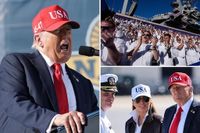On Saturday, October 18, 2025, a major stretch of Interstate 5 in Southern California fell eerily silent as traffic came to a standstill. The reason? A controversial military celebration at Camp Pendleton, marking the 250th anniversary of the U.S. Marine Corps, which included a live-fire demonstration of 155-millimeter artillery shells fired directly over the busy freeway. The abrupt closure, which spanned from Harbor Drive to Basilone Road and lasted from 11 a.m. to 3 p.m., left thousands of motorists scrambling for alternate routes and ignited a fierce political debate about public safety, federal-state coordination, and the optics of military power on display.
According to the California Highway Patrol (CHP), the "unscheduled closure" was implemented out of public safety concerns after it became clear that the Marines’ planned demonstration would send live munitions arching over one of the state’s most heavily traveled corridors. The closure was not part of the original plan; in fact, the U.S. Marines had assured state officials and the public earlier in the week that no highways or transportation routes would be affected. The event, formally titled "America’s Marines 250: From Sea to Shore – A Review of Amphibious Strength," was meant to showcase military prowess and honor the Corps’ long legacy. But as the logistics unfolded, the celebration became a flashpoint for controversy and confusion.
Governor Gavin Newsom was quick to voice his outrage. In a fiery statement released Saturday and reported by The New York Times, he declared, "This is a profoundly absurd show of force that could put Californians directly in harm’s way." Newsom went further, lambasting the federal government’s decision to proceed with live-fire exercises over a public freeway as "reckless, disrespectful, and beneath the office the president holds." He accused President Trump of putting "ego over responsibility" and argued, "Firing live rounds over a busy highway isn’t just wrong — it’s dangerous. Using our military to intimidate people you disagree with isn’t strength — it’s reckless, it’s disrespectful, and it’s beneath the office he holds. Law and order? This is chaos and confusion."
The governor’s concerns were not unfounded. About 80,000 vehicles travel the affected stretch of I-5 daily, making it a vital artery between San Diego and Orange counties. The closure not only disrupted car traffic but also led to the cancellation of Amtrak’s Pacific Surfliner train service in the area from noon to 3 p.m., as confirmed by Amtrak and reported by The New York Times. The Federal Aviation Administration also issued temporary airspace restrictions near Camp Pendleton during the event, underscoring the scale and security concerns surrounding the demonstration.
Confusion reigned in the days leading up to the event. On Wednesday, Newsom’s office began making preliminary plans to close the freeway, but they were still awaiting details from the federal government. The Marines had issued a statement late Wednesday asserting that "all events would occur on approved training ranges and comport with established safety protocols" and that no public freeways would be closed. Yet, by Friday, state officials were told to alert motorists of live fire via electronic highway signs, and after further inquiries, they learned that live fire activities were scheduled for Saturday afternoon. The lack of clear, timely communication left state officials feeling blindsided and motorists unprepared.
The Marines, for their part, maintained that the exercise was safe and routine. Capt. Gregory Dreibelbis, a spokesman for the 1st Marine Expeditionary Force, explained that M777 howitzers have historically been fired from land-based points west of I-5 into impact areas east of the interstate, within existing safety protocols and "without the need to close the route." He described the test firings conducted on Friday evening as an "established and safe practice" and a rehearsal for Saturday’s event. The shells themselves—about six inches in diameter, two feet long, and weighing around 90 pounds—are capable of traveling more than 15 miles. Marine officials did not clarify whether the rounds used were high-explosive or inert practice projectiles, a detail that contributed to public unease.
William Martin, communications director for Vice President JD Vance, pushed back against the governor’s characterization. "Gavin Newsom wants people to think this exercise is dangerous," Martin said, as quoted by The New York Times. "The Marine Corps says it’s an established and safe practice. Newsom wants people to think this is an absurd show of force. The Marine Corps says it’s part of routine training at Camp Pendleton. If Gavin Newsom wants to oppose the training exercises that ensure our Armed Forces are the deadliest and most lethal fighting force in the world, then he can go right ahead."
The event drew a crowd of more than 15,000 Marines, sailors, veterans, and their families, along with top Trump administration officials including Vice President JD Vance—a former enlisted Marine himself—and Secretary of Defense Pete Hegseth. The demonstration, dubbed an "amphibious capabilities demonstration," may have included active duty Marines coming ashore at Red Beach, a restricted oceanfront area just south of the decommissioned San Onofre nuclear power plant. Red Beach, a site once favored by President Richard Nixon for its seclusion, provided a dramatic backdrop for the display of military might.
The timing of the celebration added further fuel to the fire. Across the country, anti-Trump activists staged "No Kings" protests, including several in Southern California. The juxtaposition of military spectacle and political protest underscored the deep divisions in American public life, especially as the event became yet another flashpoint in the ongoing tug-of-war between the Trump administration and California’s state government. The two sides have clashed repeatedly in recent months, most notably when President Trump assumed control of 4,000 California National Guard troops in June over immigration enforcement protests—moves that Newsom vocally opposed.
Local officials also weighed in. Representative Mike Levin, who represents Camp Pendleton and the surrounding communities, expressed support for honoring the Marines but raised concerns about the lack of transparency and the disruption to the community. "As the proud representative for Camp Pendleton, I’ll always honor our Marines — the best fighting force in the world," he posted on X. "But reports of multi-hour I-5 closures on Friday and Saturday raise serious concerns. We should celebrate the Marine Corps’ 250th birthday with full transparency and without disrupting the community."
The closure forced drivers to find alternate routes, with Caltrans advising northbound travelers to use Interstate 15 and other state routes such as SR-94, SR-52, SR-56, and SR-78. Those heading from San Diego to Los Angeles were directed to take I-15 north to SR-91 west, while southbound travelers from Los Angeles were told to reverse the detour. The ripple effects were felt throughout the region, with delays expected before, during, and after the event.
In the end, the Marine Corps’ 250th birthday celebration at Camp Pendleton was as much a display of military tradition as it was a lesson in the complexities of civil-military relations, public safety, and political theater. As the artillery smoke cleared and traffic slowly returned to normal, Californians were left to ponder the price—and purpose—of such a high-profile show of force on their own doorstep.




